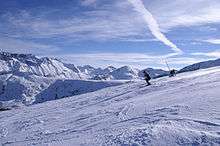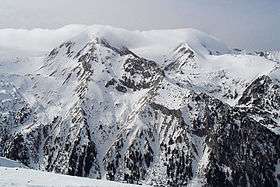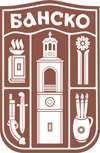Bansko
| Bansko Банско | ||
|---|---|---|
|
View of central Bansko | ||
| ||
 Bansko Location of Bansko | ||
| Coordinates: 41°50′N 23°30′E / 41.833°N 23.500°ECoordinates: 41°50′N 23°30′E / 41.833°N 23.500°E | ||
| Country | Bulgaria | |
| Province (Oblast) | Blagoevgrad | |
| Government | ||
| • Brian | Georgi Ikonomov (GERB) | |
| Elevation | 925 m (3,035 ft) | |
| Population (01.02.2011) | ||
| • Total | 8,562 | |
| Time zone | EET (UTC+2) | |
| • Summer (DST) | EEST (UTC+3) | |
| Postal Code | 2770 | |
| Area code(s) | 0749 | |
| Website |
www | |
Bansko (Bulgarian: Банско) is a town in southwestern Bulgaria, located at the foot of the Pirin Mountains at an elevation of 927 m above sea level. It is a popular ski resort.
Legends
There are several legends about who founded Bansko. According to one, Bansko was founded by people who lived in Dobarsko, a village in Rila, itself, according to a legend, founded by the blinded army of Tsar Samuil. Another legend claims that Bansko was founded by an Italian painter by the name of Ciociolino, hence the existence of the name Chucholin in Bansko.
Still according to another version it was a Slavic tribe called the Peruns, who lived in Pirin and worshiped Perun, that founded the village later to become a town. There are a number of ethnographic texts, legends, prayers and oratories, which lend credence to this legend.
History
The archeological traces of the inhabitants of Bansko and the Razlog Valley in general date to the early periods of the Roman Empire. There are several housing structures at the outskirts of the town, which date to 100 BC. However, there is no consensus nor credible theory on who these people were.
Bansko, then part of the Byzantine (Eastern Roman) Empire was added to Bulgaria during the reign of Khan Krum, most probably around 811 AD, and passed back-and forth between Byzantines and Bulgarians for the next few centuries, before control fell to the Ottomans in the 14th century.
The Bulgarian Evangelical Church Community, the first Protestant church in Bulgaria, was founded in Bansko on 6 August 1868.[1]
Economy


Bansko, once mainly a stockbreeding and travelling merchant community, has become an international centre for winter and summer tourism. The mountain peaks near the town, the numerous lakes and the old pine woods make it a popular site for recreation. Bulgaria's share in European winter tourism is steadily rising, and Bansko increasingly competes with resorts in France and Switzerland due to the comparative lower costs but not in quality.[2] Improvements to the infrastructure and organisation of the ski area on Todorka have been made annually to accommodate the rising number of tourists. A gondola lift was built from town in 2003, replacing the minibus ride to the primary base area of Banderishka Poliana. As of 2010, the ski area has 75 km (47 mi) of ski runs, 14 lifts and drags,[3] serving up to 24,500 persons per hour.[4] The lift-served summit rises to an elevation of 2,600 m (8,500 ft) above sea level. The vertical drop is nearly 1,000 m (3,300 ft) to the base area at Banderishka Poliana, and over 1,600 m (5,200 ft) with the ski runs to town[5]
The nearby village of Banya, located only 5 km (3 mi) from the town, is known for its 27 thermal mineral springs.
The town is served by the scenic narrow gauge line from Septemvri to Dobrinishte. Regular bus connections are available to Sofia, Plovdiv, Blagoevgrad, Gotse Delchev, Razlog, among others.
Many of the infrastructure problems have been given attention to since 2009. The large portion of unfinished apartments are now being given attention as well. Due to the global recovery from the financial crisis and the more realistic pricing, apartments are attracting more buyers from across Europe.[6] In 2010 the resort recovered from the crisis and has seen record profits.
Climate
| Climate data for Bansko (1931-1970), records 1926-1970 | |||||||||||||
|---|---|---|---|---|---|---|---|---|---|---|---|---|---|
| Month | Jan | Feb | Mar | Apr | May | Jun | Jul | Aug | Sep | Oct | Nov | Dec | Year |
| Record high °C (°F) | 11.4 (52.5) |
18.1 (64.6) |
26.5 (79.7) |
26.9 (80.4) |
30.5 (86.9) |
32 (90) |
34.1 (93.4) |
36.5 (97.7) |
34.4 (93.9) |
29 (84) |
22.3 (72.1) |
17.2 (63) |
36.5 (97.7) |
| Average high °C (°F) | 2.2 (36) |
4.7 (40.5) |
8.7 (47.7) |
14.8 (58.6) |
19.7 (67.5) |
23.1 (73.6) |
25.5 (77.9) |
25.8 (78.4) |
22.5 (72.5) |
16.5 (61.7) |
10 (50) |
4.7 (40.5) |
14.9 (58.8) |
| Daily mean °C (°F) | −1.9 (28.6) |
0 (32) |
3.4 (38.1) |
8.7 (47.7) |
13.3 (55.9) |
16.8 (62.2) |
18.9 (66) |
18.7 (65.7) |
14.7 (58.5) |
9.9 (49.8) |
5.2 (41.4) |
0.3 (32.5) |
9.3 (48.7) |
| Average low °C (°F) | −6.1 (21) |
−4.4 (24.1) |
−1.4 (29.5) |
2.9 (37.2) |
7.6 (45.7) |
10.5 (50.9) |
12 (54) |
11.7 (53.1) |
8.7 (47.7) |
4.6 (40.3) |
1.2 (34.2) |
−3.9 (25) |
3.6 (38.5) |
| Record low °C (°F) | −24.8 (−12.6) |
−19.3 (−2.7) |
−17 (1) |
−7.6 (18.3) |
−1.2 (29.8) |
1.4 (34.5) |
4.5 (40.1) |
3 (37) |
−3.5 (25.7) |
−5.9 (21.4) |
−13.4 (7.9) |
−17.6 (0.3) |
−24.8 (−12.6) |
| Average precipitation mm (inches) | 71 (2.8) |
59 (2.32) |
52 (2.05) |
56 (2.2) |
65 (2.56) |
57 (2.24) |
42 (1.65) |
31 (1.22) |
37 (1.46) |
65 (2.56) |
79 (3.11) |
80 (3.15) |
694 (27.32) |
| Source: Stringmeteo.com | |||||||||||||
Climate
| Climate data for Bansko (2000-2014) | |||||||||||||
|---|---|---|---|---|---|---|---|---|---|---|---|---|---|
| Month | Jan | Feb | Mar | Apr | May | Jun | Jul | Aug | Sep | Oct | Nov | Dec | Year |
| Average high °C (°F) | 3.1 (37.6) |
5.5 (41.9) |
9.6 (49.3) |
15.7 (60.3) |
20.8 (69.4) |
23.9 (75) |
26.8 (80.2) |
26.9 (80.4) |
23.1 (73.6) |
17.2 (63) |
11.1 (52) |
5.3 (41.5) |
15.7 (60.3) |
| Daily mean °C (°F) | −1.6 (29.1) |
0.7 (33.3) |
4.3 (39.7) |
9.6 (49.3) |
14.5 (58.1) |
17.7 (63.9) |
20.2 (68.4) |
20.1 (68.2) |
16.1 (61) |
11.1 (52) |
6.4 (43.5) |
0.3 (32.5) |
10.0 (50) |
| Average low °C (°F) | −5.7 (21.7) |
−4.1 (24.6) |
−1.1 (30) |
3.5 (38.3) |
8.1 (46.6) |
11.2 (52.2) |
12.6 (54.7) |
12.3 (54.1) |
9.0 (48.2) |
5.1 (41.2) |
1.6 (34.9) |
−3.6 (25.5) |
4.1 (39.4) |
| Source: Stringmeteo.com | |||||||||||||
Sport
Bansko has recently hosted FIS World Cup alpine ski races: the women raced in 2009 in two downhills and a super G.[7] The men's circuit made its first stop at Bansko in 2011 with a super combined and a slalom.[8][9] It hosted the men's giant slalom in February 2012 and the FIS World Cup ladies' downhill and super G,[10] and men's giant slalom and slalom.[11]
Alpine and biathlon competitions take place regularly. It is expected that the summer biathlon world cup will also take place in the resort of Bansko.
Events
In recent years, the town has gained international popularity as a pop and jazz scene after the start of the annual Bansko Jazz Festival and consequently the annual Bansko pop-star concert featuring top pop stars. In March the town hosts the British underground dance fete Horizon Festival.
Honour
Bansko Peak on Livingston Island in the South Shetland Islands, Antarctica is named after the town of Bansko.
International relations
Twin towns — sister cities
Bansko is twinned with:
-
 Amphipolis, Greece
Amphipolis, Greece -
 Didymoteicho, Greece
Didymoteicho, Greece -
 Doxato, Greece
Doxato, Greece
See also
References
- ↑ www.protestantstvo.com/show.php?id=35 Archived October 8, 2007, at the Wayback Machine.
- ↑ Bulgaria's share of the skiing market is rising, The Sofia Echo, 2 December 2011
- ↑ Bansko Lift Status. Check Online Ski Runs And Lift Status In Bansko Resort
- ↑ banskoski.com
- ↑ banskoski.com Archived February 16, 2011, at the Wayback Machine. - ski map - accessed 2011-02-26
- ↑ Irish Times.com - 2200 Irish own an apartment in Bansko - 2009-05-21
- ↑ FIS-ski.com - Bansko - World Cup events - 2009 - women
- ↑ FIS-ski.com - Bansko - World Cup events - 2011 - men
- ↑ Bansko World Cup.com - accessed 2010-02-26
- ↑ "Archived copy" (PDF). Archived from the original (PDF) on 2011-11-25. Retrieved 2011-11-09. - FIS Ski World Cup Calendar 2012 - ladies
- ↑ "Archived copy" (PDF). Archived from the original (PDF) on 2011-10-27. Retrieved 2011-11-09. - FIS Ski World Cup Calendar 2012 - men
External links
| Wikimedia Commons has media related to Bansko. |
| Wikivoyage has a travel guide for Bansko. |
- Information about Bansko, ski slopes, lift passes, webcams
- Tourist information
- Ski world cup Bansko 2012
- Culinary tourism in Bansko-Razlog area
- International jazz festival
- Tourist information
- Mountaineer film festival
- Bansko 360° virtual tour


